
Tokyo Disneyland is perhaps Disney's most unusual "castle" park. Its style and contents are entirely Western in the sense that no real effort was made to make Disney "more Japanese" in the way that Disneyland Paris was made with Europeans in mind. The unique qualities and individuality of the park stem almost entirely from its need to cater to the enormous, fanatic, and unrelenting crowds that pour into it all day, every day. Every FastPass for every ride runs out before the day's end; queues for popular rides can top 100 minutes by mid-day, and even on the slowest days, gift shop shelves are entirely cleared by the park's close.
Never underestimate the Japanese’s fanaticism for all things Disney. From hours before the parks open, visitors line up to get in. Keeping in mind – perfectly in tune with the rest of Japanese culture – lines are orderly, behaved, and kind. No one shoves. No one pushes. There’s absolute togetherness as the Eastern mindset of “group before individual” plays out in a real life model.
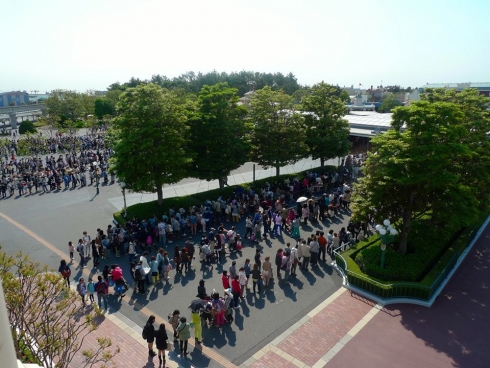 Lines form hours before parks open, but all are orderly and behaved, and disperse effortlessly into the parks once gates open.
Lines form hours before parks open, but all are orderly and behaved, and disperse effortlessly into the parks once gates open.
The idea is for everyone to have an enjoyable experience together, and to be united in the fun. Forget strollers nipping at your heels, angry parents berating tired children, and chaos at rope drop. Things are a little different here in Tokyo, as you’re about to see!
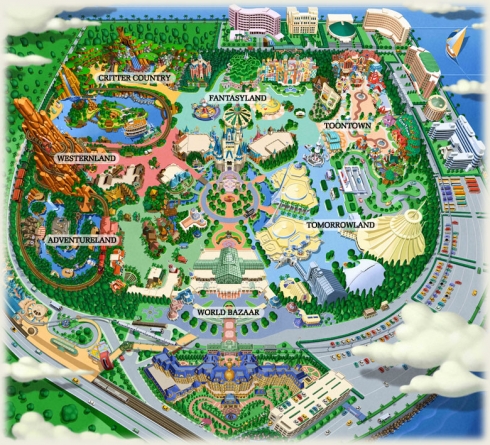 What differences do you first recognize between Tokyo Disneyland and your "castle" style park? (Click for larger)
What differences do you first recognize between Tokyo Disneyland and your "castle" style park? (Click for larger)
Click here to open a PDF map of Tokyo Disneyland in a separate window and follow along as we travel through the park!
World Bazaar
Differing climates in Tokyo necessitated one major change – Main Street, U.S.A. is absent at Tokyo Disneyland. Rather, a stand-in boulevard comprised of many different architectural styles and time periods takes its place.
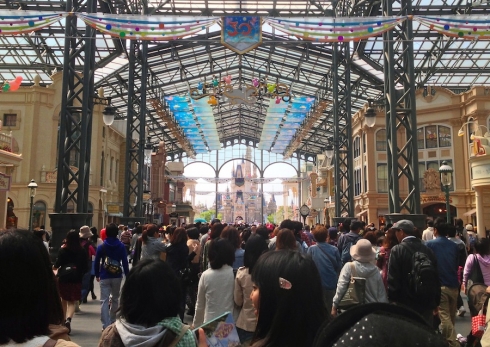
Called World Bazaar (but mostly representing America), this huge glass-canopied street is ultra-wide. And that’s not all – it’s also has two massive auxiliary outlet streets that branch off right past the park's entrance (see map above), leading to Tomorrowland and Adventureland. It’s a necessity. The massive crowds that pour into the park from opening onward simply could not funnel all the way to the hub before spilling out into the park’s lands.
The hub, though, is still here, and probably no less than three times the size of Magic Kingdom’s. The massive open plaza stands before Cinderella Castle, identical to Florida’s but for a darker, more realistic color palate of dark grays and tans.
Tomorrowland
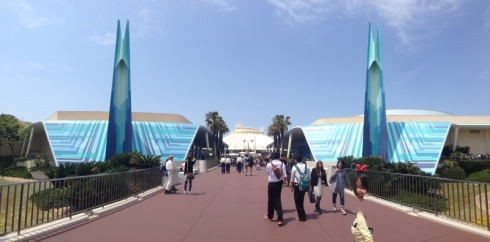 The simple, geometric entrance to Tomorrowland mirrors the Magic Kingdom's long-lost towers. What lies beyond is a "best of" grab bag of styles and rides.
The simple, geometric entrance to Tomorrowland mirrors the Magic Kingdom's long-lost towers. What lies beyond is a "best of" grab bag of styles and rides.
Across the world, Tomorrowlands have diverged in radically different styles. In Florida, we see a silver science fiction, comic book city of the 1950s. California and France turned the dial back a few centuries more for a fantasy future based in gold, seafoam, and copper. Tomorrowland in Tokyo is... well... almost exactly what it was when the park opened. That means that it’s distinctively 1980s – in fact, it’s nearly identical to the Tomorrowland in Orlando until its 1994 refurbishment (the image above could very well have been taken at the Magic Kingdom in 1992, believe it or not), and shares a stylistic brother in Epcot’s Future World in terms of architecture and even atmosphere.
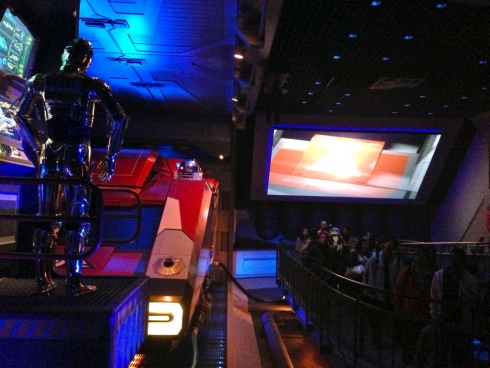 Re-opened in May 2013 with the "Adventures Continue" 3D overlay, Star Tours is a hit in Japan.
Re-opened in May 2013 with the "Adventures Continue" 3D overlay, Star Tours is a hit in Japan.
So in Japan, it’s all about geometric shapes, clean lines, and simple architecture, as evidenced by the tall blue spires at the land’s entrance – an icon that will be very familiar to Magic Kingdom fans. But it’s not that simple. Half of the land replaces the simple geometric style with an industrial one – Star Tours showbuilding has silver tubing, exposed wires, and a Panasonic satellite dish, and a retro bridge that give Orlando’s Transformer’s a run for its money (seen further below). The ride, by the way, re-opened with the “Adventures Continue” 3D overlay in May of this year, with a few unique “Easter egg” videos in the pre-show room and a massive first queue room that the other versions lack altogether.
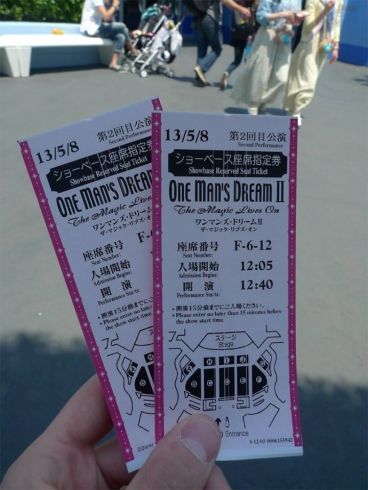
Next door is Showbase, a large outdoor theater that’s been showing One Man’s Dream II – The Magic Lives On as long as anyone can remember. An odd sequel to an odd original that played in Disneyland’s Fantasyland Theatre, the show is basically a revue show featuring the ragtag assortment of characters that the Japanese go gaga over, including Frollo from Hunchback of Notre Dame and Stitch. The camera shutters start snapping like crazy when Mickey Mouse appears, and every member of the audience sings along under their breath, mimes the lyrics to the original songs, and trips over themselves to get a picture of Mickey. Yet another testament to the odd power of Disney. The show is so popular, in fact, that Disney operates a lottery to see it - you enter into a designated lottery location, scan all your party's park tickets, then a computer randomly decides if you get to see the show or not. If you do, it prints off FastPass-style tickets with exact seat locations. If not, you're out of luck.
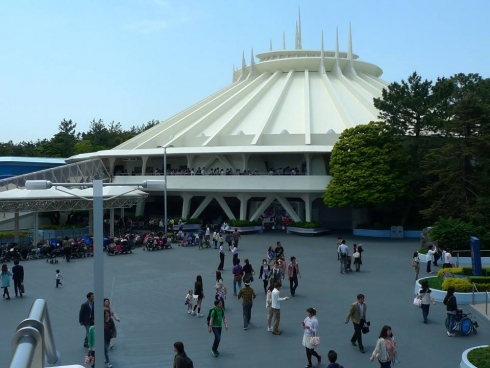
Tomorrowland also features Space Mountain, physically identical to California’s ride but without the updated effects or on-ride audio (though, curiously, with a much more updated queue and loading area featuring a sleek 21st century ship and effects compared to California’s distinctly 1970s one).
There are also the Star Jets still located on a platform, though they’re place on the second story where at the other parks, they occupy the third to leave room for a Peoplemover. In fact, Tokyo’s park was the first Tomorrowland designed without a Peoplemover. To restore the kinetic energy of motion overhead, the land has a second floor with access stairs leading to shops, restaurants, and industrial sculptures.
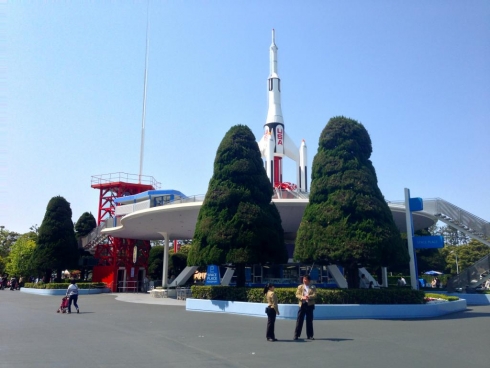
One exceptional thing we noticed at Tokyo Disneyland was a real cultural difference. In America and France, people want to ride through the stories they already know and love – they want to see their favorite characters live out the stories they’re familiar with. In Japan (as evidenced by One Man’s Dream), the focus is different. People want to see their favorite characters, but in new situations. That’s why Westerners leave the shows puzzled, saying “It was out of order... It ended so abruptly... Why did Genie show up for no reason?”

They could have built a replica of California Adventure’s Monsters Inc: Mike and Sully to the Rescue (a low-key C-ticket ride past mostly static figures retelling the movie’s plot) and instead opted for Monsters Inc: Ride and Go Seek, a 21st century dark ride through the Monsters Inc. factory for a giant company-wide game of hide-and-seek.
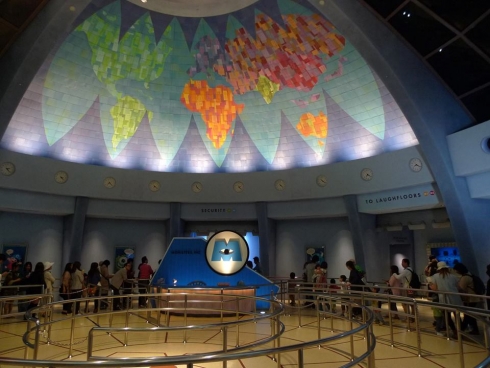 The queue passes through the full-sized dome of Monsters Inc. - an element that would undoubtedly have been cut from the budget anywhere else.
The queue passes through the full-sized dome of Monsters Inc. - an element that would undoubtedly have been cut from the budget anywhere else.
Armed with a real flashlight, you ride through the dark factory and shine your light on the familiar blue helmets to activate scenes and reveal monsters. It’s all in good fun, too, with no scoring or competition, creating a really incredible ride with full-motion animatronics and massive scenes. We'll return to this amazing attraction in Part V.
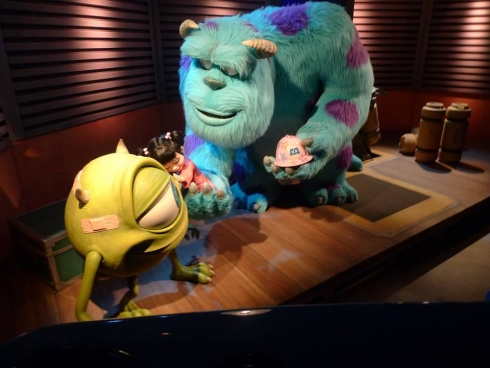 Full Audio-Animatronics figures accompany you through the ride.
Full Audio-Animatronics figures accompany you through the ride.
Tomorrowland in Tokyo is "identity-less" more than any other Tomorrowland in the world. Tomorrowland here is not a functioning city of the future, nor is it stylistically united under one color scheme or archetectural style. But very sincerely, none of that matters here. People fall head over heels for the stories, characters, and settings of Disney, and Tomorrowland to the Japanese is a world where they can meet those characters and live those stories like never before. That's enough!
Fantasyland
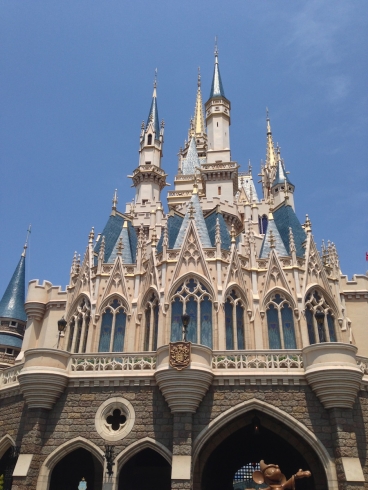
An odd amalgamation of Florida and California’s Fantasylands, this part of the park is half circus tents, half quaint forested village. All the classics are here, including Peter Pan’s Flight, It’s a Small World, Pinocchio’s Daring Journey, Snow White’s Scary Adventures, and Mickey’s Philharmagic. The park's icon, too, is an almost-exact replica of Florida's Cinderella Castle. In Tokyo, though, it's painted tan and royal blue instead of grey and sky blue. As well, the interior does not feature a restaurant, but a walk through of Cinderella's story told through different art forms, culminating in the two-story throne room where the glass slipper is on display.
The most interesting change is the presence of The Haunted Mansion. Renowned for being located in a different land at each park is resides in, the mansion is located in Fantasyland here due to cultural understanding of ghosts as fantastical things. To match, the mansion’s exterior is identical to Florida’s, but with broken windows, tattered curtains, and two menacing red-eyed griffins guarding the entrance. Inside, the ride resembles Florida’s before its M.C. Escher makeover, so giant black light spiders haunt the halls.
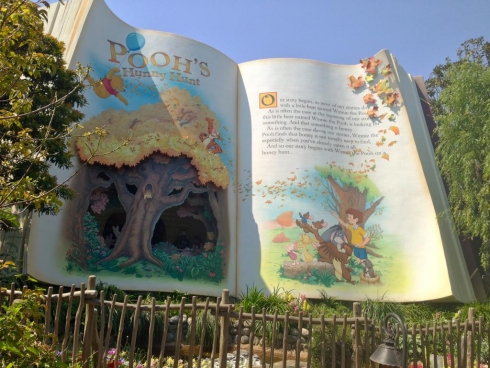
Fantasyland’s most renowned ride is the incredible Pooh’s Hunny Hunt, a new take on the dark ride present at other Disneyland-style parks. Replacing a leisurely stroll with Local Positioning System vehicles, three “hunny pots” enter the attraction at once, diverging down different paths, re-uniting, spinning, and bouncing in an orchestrated “dance” through full-scale scenes. Again, more details are forthcoming in Part V of this series.
Critter Country
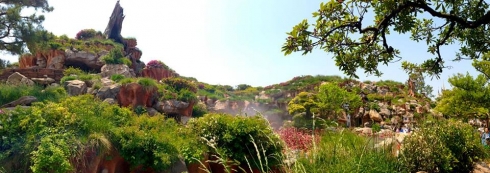
Perhaps the most visually impressive land at the park, Critter Country occupies a unique position on the far shore of the Rivers of America. Unlike its American cousins, Splash Mountain is not just the simple, prickly Chickapin Hill. In an effort to make the area feel welcoming and familiar (as any laid back rabbit would want you), the mountain is expanded into a full, wide mountain range of hills and canyons and rivers that encircle the entire land. As well, they land is covered in lush foliage that’s all native to Japan (a distinct difference from the rest of the park, which was purposefully constructed to be as Western as possible), creating a beautiful and totally comfortable mountainside on par with New Fantasyland.
Compare Disneyland California's Splash Mountain with Tokyo's.
As well, Splash Mountain does not load in an open valley alongside the mountain, but rather, loads deep within its darkest caverns, with incredible rock work surrounding. Observers may also note that you’re literally at the heart of the mountain – the roots overhead are those of the dead tree stump famously positioned at the top of Chickapin Hill. The ride itself is just as detailed and heartwarming as its sisters, telling the tale of a rabbit who decides he’s getting out of his home in the prickly briar patch, only to learn a moral in the end: “Zip-a-dee-doo-dah, zip-a-dee-ay, home sweet home is the lesson today!”
Westernland
Showcasing the best of the late 1800s American frontier, Westernland is anchored by Big Thunder Mountain, fried chicken restaurants, and the Rivers of America. The wide-open streets of Tokyo Disneyland present a unique perspective of the typically tight Frontierland model. There’s also The Country Bear Jamboree, presented half in English and half in Japanese – Big Al’s part is in English, of course.
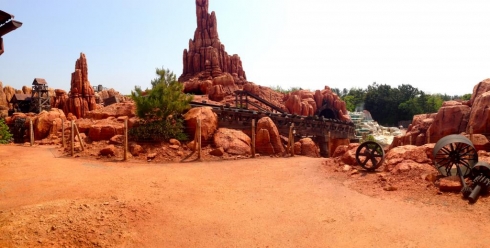
Westernland also contains Tom Sawyer Island, here influenced heavily by the style of Big Thunder Mountain. In fact, most of Tom Sawyer Island is covered in the rusty, iron-rich red rock spires so identified with Big Thunder. The "Western" food here (french fries and fried chicken) is also superb!
Adventureland
While Disneyland’s Adventureland was united under a common time and place setting with the addition of the Indiana Jones Adventure in 1995, all the other Adventurelands across the globe present a grab bag of cultures, styles, and themes. That’s perhaps no more evident than at Tokyo Disneyland, where Adventureland strikes all chords at once.
An alley of restaurants and overturned tugboats resembles the whimsical style of Typhoon Lagoon. The Swiss Family Treehouse is here representing the South Pacific, while Pirates of the Caribbean (nearly identical to Disneyland’s, but abridged; still with a Blue Bayou restaurant within) is located in a sub-area within Adventureland that nonetheless resembles the style and size of New Orleans Square at Disneyland.
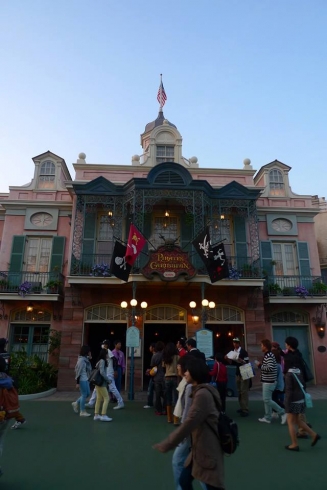 Tokyo Disneyland's Pirates looks a lot like California's - and indeed, it's even located in a New Orleans sub-area of Adventureland.
Tokyo Disneyland's Pirates looks a lot like California's - and indeed, it's even located in a New Orleans sub-area of Adventureland.
The Jungle Cruise follows its normal path around the world (though a $16 million refresh of the attraction announced in July 2013 signals that it will gain a new storyline, incredible new effects, and synchronized on-ride audio). The Western River Railroad boards above the Jungle Cruise's station, replacing the circumnavigating train of the other parks (due, again, to Japanese regulation for timetables and fees on all transportation) and encircles the Rivers of America, Big Thunder Mountain, and Splash Mountain despite being an Adventureland ride.
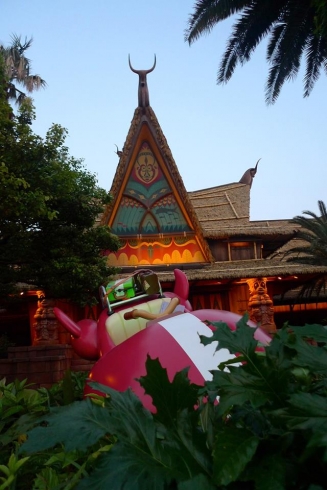
Then, of course, there’s The Enchanted Tiki Room: Stitch Presents Aloha e Komo Mai, a Hawaiian take on Walt Disney’s classic where Stitch interrupts to hilarious results complete with crashed space ship out front and blue graffiti within. Stitch is one of those characters the Japanese just can't get enough of, and while this attraction plays off no less oddly than Florida's Iago-and-Zazu version, the clientele enjoy it immensely, which makes it an undeniable success.
Conclusion
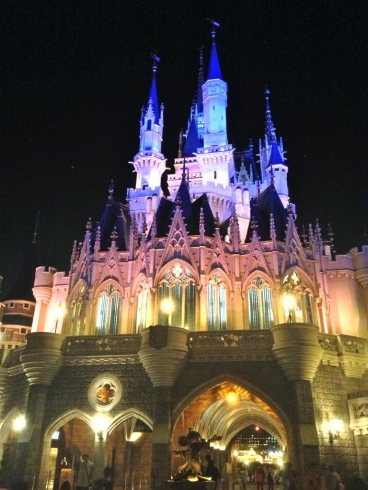
Tokyo Disneyland strikes familiar chords, but maintains a separate and unique identity among Disney Parks. Just as you think you know what’s around the corner, something unique pops up! Among Disneyland-style parks, Tokyo Disneyland still holds its own as a quality and timeless park. Even visitors who are effortlessly familiar with the nooks and crannies of Magic Kingdom, Disneyland Park, and Disneyland Paris will be gobsmacked by the new alleys, "misplaced" rides, and diversions from standard style.
Through it all, though, Tokyo Disneyland well represents the magnificence of Japanese culture. Every effect works, every corner is scrubbed. Every queue is orderly and polite, even for shows! Not once did I see a piece of gum on the ground (and I checked). There's a tremendous sense of pride surrounding this historic park, and instead of quibbling over details and breathlessly demanding updates and rethemes and cohesion, the Japanese just authentically enjoy the chance to see their favorite characters and live their favorite stories. There's a magnificent innocence to that that must be seen to be believed.
Next, we'll hop on board the Disney Resort Line and make our way to Tokyo DisneySea Station for a stop at what some say is the best theme park in the world.

Add new comment